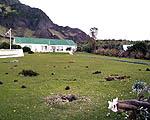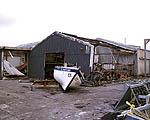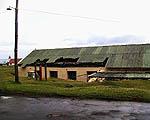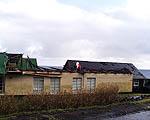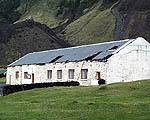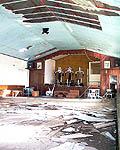The Residency, and three longboats which were stayed to the ground by ropes on the left hand side of the wall, note the one to the right in the flax.
Tristan da Cunha is an Overseas Territory of the United Kingdom, and known as the remotest inhabited island in the world. There is only one inhabited area, and this is known as Edinburgh of the Seven Seas on Tristan. It is a small village of just under 300 people.
With autumn closing, everyone was preparing for a wet winter. Two weeks previously one gale had come and torn off an islander’s roof, in such a way no one had experience, but worse was to follow on Monday the 21st May.
It was a grey murky morning, overcast and raining with a stiff breeze. Work started in the normal way, but around 9.00am the wind started to increase from the South east, the sea started to become a continuous whirlwind of white water, and by 11.00am a ferocious storm stuck the island. All Heads of the various Government Departments were inform to let their staff stop work and return to their homes as the wind continue to became stronger and the asbestos roofing was starting to blow off various Government Department buildings.
People could be seen running from one building to another, for shelter, helping each other to secure their doors and roofs often blown off their feet, to avoid the flying debris (mostly asbestos) which could easily have decapitated anyone before being blown clean off the Island into the sea. The fish Factory freezer was lifted from its foundation and thrown 20m up the road, and a quarter of the fishing factory roof was damage or taken completely off.
At approximately 12:30pm all men were asked assemble at the hospital to try and salvage the hospital equipment, and prevent any more of the roof to be blown off. Ropes were thrown over the roof and tied down, nothing else could be done due to the force of wind and rain, which pelted into ones face like pins horizontally. The gable end of the hospital collapsed and a quarter of the hospital was blown down, losing the theatre and x-ray room.
Tremendous damage was done to the Prince Philip Hall, the only community centre, and Pub (The Albatross bar) on the island. The sheets of asbestos roofing and overhead verandas were torn from the back and front of Prince Philip Hall, the loft of the main dance hall fell in and the whole building became waterlogged. Three of the Tristan longboats, unquint to Tristan and secure by metal spikes in the ground outside of the Residency garden, were lifted and tossed into the garden, with one being lifted through the air sixty metres and deposited in the Rectory’s back garden, demolishing his potato shed.
Power cables were blown down and scatted the village like a tangle fishing net, that night the inhabitants of Edinburgh settlement sheltered nervously in the dark or in candlelight, some in inches deep water, others in neighbours homes. The majority of the community sat up all night, wondering if their roof was going to be the next to be ripped off, or waiting for the call of a neighbour to help. Comments made by the eldest pensioner on the island ninety-four, was that she had never heard weather like that since her birth. The wind screeching and howling becoming quite deafening at times.
With all lines down and the 100ft Jaguar, although held by eighteen steel cables listed over, the island was totally cut of from the outside world. A number of roofing sheets had blown off the radio shack, and when the window blew in it sucked the mobile sat phone out, and the rest of the radio equipment becoming waterlogged. However their was a spare and with this the following day the Acting Administrator called the FCO to inform them that Tristan would be out of contact until the electricity supply could be restored. One of the satellite dishes just install a few months ago was totally demolished ripped off the mounting.
The day after the storm, despite wind and rain the islanders systematically worked on the houses which roofs had blown off, whilst the women helped one another dry out flooded rooms and passages. They worked all day and before dusk that night all Islanders houses roofs had been replaced.
Thanks to the efficiency of the electricians on the island a temporary line was install from the Factory and the following day the Administration office was back in operation, the villages remain without electricity for six days. Whilst the islanders cleaned up the village the same force of wind and rain came from the West hitting the potato patches four miles to the west, again causing great damage. Camping huts roofs and as many as twenty seed sheds to the west of the settlement which holds next years crop was blown away and seed damage, probably affecting next years potato crops, which could be disastrous.
For the last six days all islanders worked in oilskin suits from dusk till dawn to restore the damage, and to secure what could not be rebuilt until funds and supplies became available, and although being an islander I am amaze at the amount of work that has been accomplished.
It is not yet know how many cattle died in this storm, but the figure at the moment is thirty and continues to rise. The lost to the Island sheep flocks is unknown but thought to be considerable, and this is only on the settlement plain. As yet the weather has not allowed us to visit the back of the Island or the Islands of Nightingale and Inaccessible.
The roofing was torn from the Anglican Church Vestry and the Tower Bell blown down, but
it did not deter the islanders, for on Sunday morning (27th May) both churches were packed, to give thanks that no serious injury or loss of life took place amongst the islanders. The electricians then switched on the village electricity supply and checked every house on the island. That night for most of us life was back to almost normal.
Its common knowledge that most islanders are not well off, the average wage for Government employees on Tristan is £152.34 per month. The aftereffects of the storm will cost much hardship as families try and restore their properties and possessions. A local Disaster Fund has be set up to help those less fortunate, and Community sprit is stronger than ever. The island has no Insurance Company, no source of reserve and help is desperately needed to ease the financial loss. The thoughts of the Islanders are, despite the loss and damage done, the most important thing, is that we can thank God that no one was hurt during this storm, the sun shines, and half of the Union Jack still flies on the remotest Island of Tristan da Cunha.
James Glass
Chief Islander - Acting Administrator
(Extracts taken from ‘The Tristan da Cunha Storm of 2001’ by Revd. Dr. A.P van der Merwe)
Part of the Fish Factory
The Back of the Prince Philip Hall
The Hospital, and Doctors house
Half of the Union Jack still flies, Saw mill building in the back ground.
Prince Philip Hall
The inside of the Prince Philip Hall
